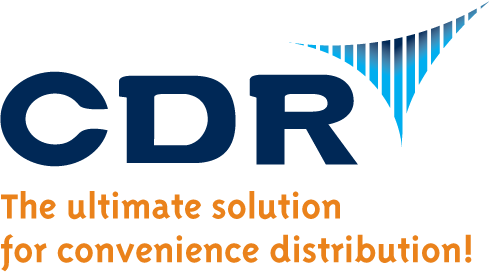Struggling with inventory accuracy or fulfillment delays? A smart warehouse management solution—like a WMS—might be the answer.
In the fast-paced world of convenience distribution, warehouse operations can make or break your bottom line. When your business depends on getting the right products to the right place at the right time, even minor delays or inventory inaccuracies can ripple across your entire operation.
That’s why having the right systems in place isn’t just helpful—it’s essential. Whether that means implementing a standalone WMS or adopting warehouse functionality integrated within a broader ERP solution, choosing the right approach can set the foundation for long-term success.
What Is a Warehouse Management System (WMS)?
At its core, a Warehouse Management System (WMS) is software that helps businesses control and optimize their warehouse operations. It’s designed to give real-time visibility into your inventory and streamline tasks like receiving, putaway, picking, packing, and shipping.
A good WMS ensures that every product in your warehouse has a clear path—from the moment it arrives, to when it’s loaded onto a truck for delivery. It tracks where items are stored, helps workers know exactly where to go, and keeps your inventory data up to date with every move.
Key functions of a typical WMS include:
- Inventory management: Keep accurate counts across all locations.
- Order picking: Speed up fulfillment with optimized pick paths and packing logic.
- Receiving and putaway: Ensure goods are logged and stored correctly from the start.
- Shipping and staging: Coordinate efficient outbound workflows.
- Tracking and reporting: Gain insight into warehouse performance and trends.
Whether operating a single warehouse or multiple locations, a WMS can help keep operations running smoothly, staff working efficiently, and customers happy.
WMS vs. ERP: What’s the Difference?
While a WMS focuses specifically on the processes within your warehouse, an Enterprise Resource Planning (ERP) system is built to manage your entire business—from accounting and sales to inventory and procurement. That broader scope can be both a strength and a challenge.
A standalone WMS offers highly specialized warehouse functionality, which can be ideal for large operations with complex logistics needs. But it typically needs to be integrated with your ERP system to share data across departments. This setup can lead to additional costs, data silos, and synchronization issues if not managed properly.
On the other hand, some ERP systems include warehouse management features as part of their core offering. This can be a more seamless and cost-effective option—especially for industries like convenience distribution, where agility and simplicity are key.
Here’s a quick comparison:
| Feature | WMS | ERP with WMS Functionality |
| Focus | Warehouse operations only | Entire business, including warehouse |
| Integration Required | Yes, with ERP | No—built-in functionality |
| Customization | Often high | Varies by industry focus |
| Cost | Additional software | Included (or small module fee) |
| Ideal for | Complex or high-volume logistics operations | Convenience distributors and businesses wanting a streamlined, all-in-one solution |
For convenience distributors, the right choice often comes down to ease of use and industry fit. A generic ERP with limited warehouse features may fall short—while a standalone WMS may add unnecessary complexity. That’s where a purpose-built ERP with robust WMS capabilities shines.
Related: WMS vs ERP: Which is Better for Your Distribution Business
Top Benefits of Implementing a WMS

Investing in a Warehouse Management System can transform the way your warehouse operates day-to-day. Whether you’re dealing with frequent order errors, slow fulfillment times, or inventory blind spots, a WMS–or ERP with WMS functionality–helps create a more organized, efficient, and responsive warehouse environment.
Here are some of the top benefits you can expect:
Improved Inventory Accuracy
Manual tracking or outdated systems often lead to discrepancies between what’s on the shelf and what’s in your system. A WMS provides real-time inventory visibility, reducing stockouts, overstocking, and the costly surprises that come with them.
Faster and More Accurate Order Fulfillment
With optimized pick paths and guided workflows, your team can fulfill orders faster and more accurately—boosting customer satisfaction and cutting down on returns or complaints.
Better Warehouse Space Utilization
A WMS can help you make smarter use of your warehouse layout by recommending the best storage locations based on item velocity, size, or demand—reducing travel time and wasted space.
Labor Efficiency
By automating task assignments and providing step-by-step instructions, a WMS helps employees work smarter, not harder. This leads to reduced training time, fewer errors, and a more productive team overall.
Real-Time Visibility and Reporting
From performance dashboards to detailed audit trails, a WMS gives managers the data they need to make informed decisions quickly. You’ll be able to identify bottlenecks, spot trends, and improve workflows over time.
Compliance and Traceability
For distributors handling food, beverages, or other regulated products, traceability is critical. A WMS ensures you can track lot numbers, expiration dates, and product movement—making compliance easier and strengthening customer trust.
When all these benefits work together, the result is a warehouse that runs more smoothly, adapts more easily, and delivers better outcomes for your entire business.
How a WMS Can Transform Warehouse Operations
Implementing WMS functionality doesn’t just improve individual tasks—it has a ripple effect across your entire operation. With better control, visibility, and automation in place, your warehouse becomes a well-orchestrated environment where everything flows more smoothly.
Here’s how a WMS can drive real transformation:
More Streamlined Workflows
From receiving and putaway to picking and shipping, a WMS eliminates guesswork and manual processes. Tasks are assigned intelligently, and workers know exactly what to do and where to go—reducing delays and confusion on the warehouse floor.
Fewer Errors, Less Rework
By automating data capture and guiding employees through each step, a WMS significantly reduces errors in inventory handling and order fulfillment. That means fewer returns, fewer customer complaints, and less time spent fixing mistakes.
Scalability Without Chaos
As your business grows, so does the complexity of your warehouse operations. A WMS helps you scale without losing efficiency. It supports higher order volumes, more SKUs, and additional warehouse locations—without requiring a complete overhaul of your processes.
Faster Decision-Making
With real-time data and performance metrics at your fingertips, warehouse managers can respond quickly to issues, optimize labor allocation, and make proactive improvements that impact the bottom line.
When you zoom out, it becomes clear: a WMS doesn’t just support your warehouse—it strengthens your entire supply chain. And when your warehouse is running at full efficiency, your customers notice the difference.
For convenience distributors, the best results often come from using a system that understands their unique operational challenges. That’s where DAC ERP from CDR Software comes in—offering an all-in-one platform with warehouse management capabilities built specifically for our industry.

CDR Software’s DAC ERP: Warehouse Management Built for Convenience Distribution
While many ERP systems offer basic warehouse functionality, DAC ERP from CDR Software goes further by delivering warehouse management features designed specifically for the unique demands of convenience distribution.
Instead of bolting on a separate WMS or relying on limited tools, DAC ERP integrates advanced warehouse capabilities directly into your core business system—streamlining operations without adding complexity.
Here’s how DAC ERP supports smarter warehouse management:
- Real-Time Inventory Tracking: Know exactly what’s in stock, where it’s located, and how fast it’s moving. DAC ERP helps reduce shrinkage, prevent stockouts, and maintain accurate inventory across all warehouse locations.
- Order Picking and Route Optimization: Whether you use batch picking, zone picking, or truck route planning, DAC ERP guides your team to the most efficient pick paths and packing methods—ensuring fast, accurate order fulfillment.
- Shelf-to-Truck Accuracy: DAC ERP supports scanning and validation at every stage, reducing the chances of mispicks or delivery errors. You can trust that the right product is going to the right customer, every time.
- Lot and Expiration Tracking: For products with expiration dates or lot codes, DAC ERP offers complete traceability—helping you stay compliant with industry regulations and ready for audits or recalls.
- Warehouse-Level Reporting and Dashboards: Get the insights you need to improve performance and identify bottlenecks. DAC ERP offers clear, customizable reports to help managers make better decisions based on real data.
What sets DAC ERP apart is that it’s built with convenience distributors in mind. It’s not a generic system trying to fit your workflow—it’s a tailored solution that understands your business from the receiving dock to the delivery truck.
Is It Time to Rethink Your Warehouse Management Strategy?
If your warehouse team is constantly putting out fires—chasing down missing products, correcting pick errors, or struggling to meet delivery deadlines—it might be time to take a step back and evaluate the systems driving your operation.
Ask yourself:
- Are we relying on manual processes or outdated software?
- Do we have real-time visibility into inventory and order status?
- Can we scale our operations without sacrificing accuracy or speed?
- Are errors or inefficiencies in the warehouse affecting our customer relationships?
A strong warehouse management strategy isn’t just about organizing shelves—it’s about building a reliable, efficient, and scalable foundation for your entire business. With the right system in place, your warehouse becomes a competitive advantage rather than a source of stress.
For convenience distributors, the best solution is one that understands the unique pace and complexity of your industry. DAC ERP offers that edge—with powerful WMS capabilities built into a platform designed to serve your whole operation.
Conclusion & Call to Action
A well-run warehouse can be the backbone of a thriving distribution business—but only if you have the right tools to support it. A Warehouse Management System brings structure, visibility, and control to every stage of your operation, from receiving inventory to shipping out customer orders.
While many businesses rely on separate systems for ERP and warehouse management, DAC ERP from CDR Software brings everything together in one platform. Purpose-built for convenience distribution, it delivers the warehouse functionality you need—without the complexity or cost of a standalone WMS.
If you’re ready to improve accuracy, speed, and efficiency in your warehouse, it might be time to rethink how your current systems are serving you.
Ready to streamline your warehouse and strengthen your entire operation? Schedule a demo of DAC ERP today and see how purpose-built convenience distribution tools can move your business forward.
FAQs
What is the main purpose of a Warehouse Management System (WMS)?
A WMS is designed to optimize warehouse operations by managing inventory, improving order accuracy, and increasing efficiency across receiving, picking, packing, and shipping.
How is a WMS different from an ERP system?
A WMS focuses specifically on warehouse tasks, while an ERP system manages business-wide functions like accounting, purchasing, and sales. Some ERPs—like DAC ERP—include integrated warehouse management capabilities.
Does CDR Software’s DAC ERP include WMS features?
Yes. DAC ERP includes built-in warehouse management tools tailored for convenience distributors, such as real-time inventory tracking, order picking optimization, and lot tracking.
What are the benefits of using a WMS in convenience distribution?
A WMS improves inventory accuracy, speeds up order fulfillment, reduces warehouse errors, and helps maintain compliance—making operations more efficient and customer service more reliable.
Is a standalone WMS better than an ERP with WMS features?
It depends on your business needs. For convenience distributors, an ERP like DAC ERP with robust, built-in WMS functionality offers a more seamless, cost-effective solution than managing two separate systems.

